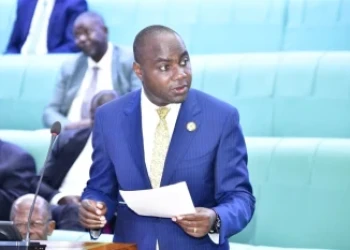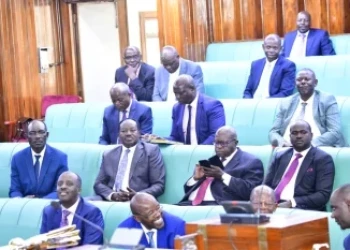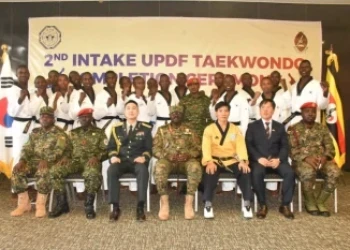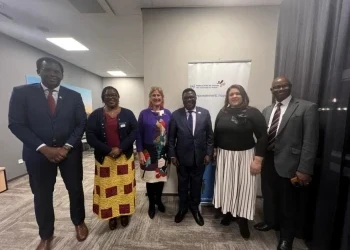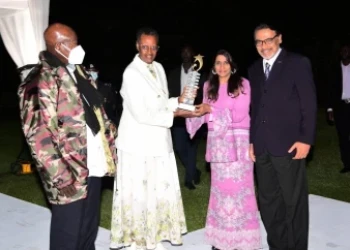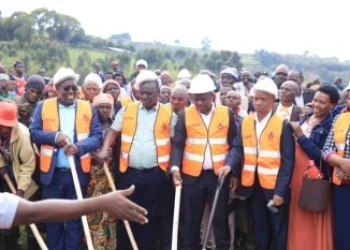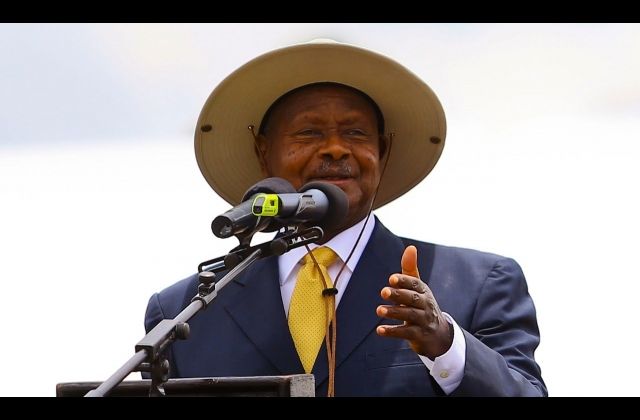
It is with great pleasure and honour that I welcome Your Excellencies and all the distinguished guests to this occasion as we mark 54 years of Uganda’s independence.
I congratulate Ugandans on the 54th Independence Anniversary of our country. I wish you a prosperous 55th year of Independence.
As I have told you repeatedly, over the last 55 years, the NRM and its precursors have identified ten strategic bottlenecks. These are:
(i) Ideological disorientation;
(ii) A weak State, especially the army, that needed strengthening;
(iii) Under-developed infrastructure (the railways, the roads, the electricity, the telephones, piped water, etc.);
(iv) The underdevelopment of the human resource (lack of education and poor health for the population);
(v) Interfering with the private sector (either by policy or by corruption);
(vi) A fragmented African market on account of colonialism;
(vii) Exporting unprocessed raw materials and, therefore, getting little money and losing jobs and lack of industrialization;
(viii) The underdevelopment of the services sector (hotels, banking, transport, insurance, tourism, etc);
(ix) The underdevelopment of agriculture;
(x) The attack on democracy.
By the time we eliminate or significantly reduce all the ten bottlenecks, Uganda will be a modern country. These bottlenecks need to be tackled in a holistic way. We have already tackled the problem of ideological disorientation; the problem of the weak State (especially the army); the problem of the fragmented African markets that needed integration; the problem of infrastructure such as electricity, improved roads, the ICT backbone, some piped water for some towns, educational infrastructure, the health services infrastructure, etc; the emancipation of the private sector; etc., etc.
Especially by handling electricity, the improved roads and ICT backbone, we are on the verge of lowering the costs of doing business in the economy, especially in manufacturing. The only problem remaining is on account of the high electricity prices caused by the Bujagali power station of 11 American cents. The power from Nalubaale is US 3 cents because we have finished paying the loans. Recently, in New York, I had a serious discussion with the stakeholders involved in the Bujagali project and agreed on how to bring down the cost of power of that power station.
By a number of measures, the cost of Bujagali electricity can go down to US 7 cents. Thereafter, we can undertake further measures that can bring down the cost of a unit of electricity to US 5 cents for, at least, the manufacturers. Apart from bringing down the cost of power, we are building new dams to ensure that Uganda will never, again, be in shortage of electricity.
In order to further deal with the high cost pushers in manufacturing and business, we are also going to build a modern electrified standard gauge railway. In a manufactured product, electricity accounts for 40% and transport accounts for 50% (World Bank). Once, therefore, you tackle these two (electricity and transport), you significantly lower the costs of doing business in any given economy.
Now that we are, finally, addressing the cost-pushers of electricity, road transport and rail transport, we remain to deal with the total monetization and modernization of agriculture, industrializing the country and continue to develop the services sector.
The total monetization of agriculture will mean persuading the 68% of the homesteads that are still in subsistence farming to join commercial agriculture. Operation Wealth Creation is continuing to distribute coffee seedlings, fruit seedlings, tea seedlings, etc. Since Operation Wealth Creation started in 2013, they have given out a total of 122 millions coffee seedlings, 11 million fruit seedlings, 15 millions of tea seedlings. This is in addition to the seedlings of maize, banana suckers, dairy heifers, cassava, piglets, poultry, etc.
Unfortunately, I am told that around 40% of the coffee seedling have dried up because of the beneficiaries not watering them. This is terrible carelessness. It is so easy to water coffee seedlings and similar plants by fetching water from a nearby swamp on a bicycle in a kidomola (a jerrycan), distributing the water into plastic water bottles, putting a small hole in each bottle and putting each near the kikolo of the plant (near the roots). This is simple drip irrigation. The plant will not dry in the dry season. Therefore, please stop this carelessness (obutafaayo). However, agriculture needs to do more. There is sometimes the problem of leeched soils that are deficient in phosphorus, potassium and nitrogen. You should carry out zonal tests and advise the farmers accordingly, through intensive radio, sensitization. I recently got Dr. Zaake to check on my land in the fertile Ntungamo area and we found that, the good rainfall in the area notwithstanding, the soil was very deficient organic matter, nitrogen, calcium and magnesium but relatively deficient in phosphorous nd potassium, caused by the leeching in the sandy soil. The other big problem for agriculture is the occasional erraticness of the rain. The answer for this is irrigation-mega and micro. We have already repaired the mega-irrigation schemes of Doho in Butaleja, Mobuku in Kasese, Olweny in Lango, Agoro in Lamwo and Kibiimba in Bugiri. I, however, would not like to multiply the Olweny and Kibiimba type. They encroached on the wetlands. Mobuku, Doho and Agoro are more correct conceptually because they involve diverting River water and irrigating the terrestrial portion of our country and not encroaching on the wetlands ─ in effect tampering with the tributaries of the Nile River. We are going to extend those types around Mount Elgon, the Rwenzoris, the Kigezi highlands and the Agoro range.
This is where you use the mountain ranges to solve your civil engineering needs and you simply channel the water taking advantage of gravity. The other mode of irrigation is to use solar water pumps, pump water from a lower elevation to a higher one and irrigate the nearby fields. The Ministry of Agriculture is already directed to have those solar-pumps assembled and manufactured here, in the country. During the Katuumba rains (March to May), we got so much water that Lake Victoria got to 12.67 , metres at Entebbe almost equaling the record of the 1961-64 rains when the comparable level was 13-46 metres.
Indeed, during the Katuumba rains, the whole shore-ine of Lake Victorawas flooded. Inside of Kyaanda (dry season ─ Kyeeya) of June-July that has gone on up to September on account of Al-ninna, the level of the Lake is still at 12.11 metres. All my dams at Kisozi and Rwakitura are still full. It is, therefore, an irrationality to cry about the drought when the Lakes are full of vast quantities of water. The answer is solar water pump for standby irrigation when the rain delays.
Chinese friends are, finally, helping us to manufacture phosphate fertilizers at Sukuru hills in Tororo. Eventually, we hope to blend the Tororo phosphates with the potassium from Lake Katwe and Nitrogen from the oil fields in Lake Albert or importing some from our Tanzanian brothers so that the NPK fertilizer is processed and formulated here.
Do not, however, forget that the other danger to stable commercial agriculture in Uganda is land fragmentation through archaic systems of inheritance. You the leaders need to aggressively sensitize the people on this issue.
On the side of livestock, the remaining challenge is to ensure that we provide good pasture for the cattle, both in the rainy and dry seasons. The farms everywhere must be planted with chloris Guyana (orunyankokoore), bracheria (ejubwe), hyperania ruffa (emburara), panicum maxima and minima (obuteera-nte) as well as the newly recommended fodder crops such as sorghum etc. etc. We cannot continue to have bad grasses in our farms such eyojwa (rhodenta Kaperansis) like the one I saw in Nyangoma the other day, egaashe, kasibante in Luganda (Sporaborus), omuteete (cymbopogan afronudus) etc. and talk of farming. The Ministry of Agriculture should solve the issue of tractors. Acquiring tractors is not a problem. The problem are the people to entrust the tractors with. Should we give them to Cooperatives or to rich individual farmers? I have been giving out tractors to some community groups. We have agreed in the sector meetings that Agriculture standardizes this. The issue of ticks is being handled. Apart from changing the acaricides, there is the solution of vaccines like the one of East Coast Fever or even the anti-tick vaccine.
The issue of industrializing our country will be handled in four ways.
First of all, the Ugandan investors who have already done a good job. These will be assisted to expand. I also encourage them to source new partners from outside or inside. Then there are the FDIs (the Foreign Direct Investments). The crucial point here is prompt decision-making by our officials. No delays.
The third source of manufacturers are our scientists whom we have assisted to get patents after their inventions. Those are being assisted with our direct funding. These include the banana project for flour and starch, the juice project, the Luwoko (phytolaccadodecandra), etc.
The fourth group are the youth, the women and the cooperative groups that we are assisting to acquire machinery for processing most of our agricultural, mineral and forest raw-materials into finished products. The UNBS is being strengthened to assure quality.
The services sector, especially tourism, is growing very well on account of robust security and the good roads. Yesterday we were at Hotel Africana for the Prayer Breakfast, I inquired and they told me that the occupancy rate was 80%. The other services are also growing ─ banking, insurances, transport, etc.
The other effort has been in the area of providing cheap finance for the manufacturers. We are going to give capital to Uganda Development Bank (UDB) to the tune of Shs. 50 billion this financial year.
Then, gradually, it will be increased up to 500 billion shillings over the medium term. They can, then, lend that money to the manufacturers at the interest rate of 15%.
The final effort is on the issue of the airline. We allowed Uganda Airlines to die because it was making losses and, at that time, Ugandans were not travelling as much as today. Somebody has told me that Ugandans are spending US$420 million per year on travel. Therefore, the NRM Government has decided to start a National Airline to stop the outflow of this money and to end travel inconveniences to Ugandans. We are now finalizing the modalities.
Therefore, my dear Ugandans, I can confidently tell you that the future is bright. In Africa, we are integrating our markets. Our produces are, therefore, assured of the internal market of Uganda, the regional market and the international markets. While purchasing power outside Africa is declining or stagnant, the purchasing power in Africa is going up. The purchasing power is one of the most important stimuli for production and growth.
I once again congratulate all Ugandans upon celebrating the 54th Independence and wish you good luck and happy celebrations
Comments (0)
📌 By commenting, you agree to follow these rules. Let’s keep HowweBiz a safe and vibrant place for music lovers!


